Abstract
Alternative polymer-based filter media and ornamental plants in constructed wetlands (CWs) are a relatively unexplored field. These approaches have the potential to reduce construction costs and enhance the aesthetic appearance of CWs. This study evaluated for the first time the use of ornamental plants as monoculture and polyculture, as well as the incorporation of polyethylene terephthalate (PET) as a filter medium in a large-scale community HC (divided into 12 cells) for the treatment of municipal wastewater. Duplicate cells were planted with monocultures of Canna hybrids, Spathiphyllum blandum, Anturium spp., and Thypa spp., while two units had mixed cultures of these plants and two control units remained without vegetation. Systems with vegetation achieved average removal efficiencies of 86.95, 81.3, 64.6, 85.2, and 52% for COD, BOD5, TSS, TP, and TN, respectively. Meanwhile, in systems without vegetation, the removal efficiencies for these pollutants were 81.33, 72.86, 43.68, 3.93, and 30.70%, respectively, indicating significant differences between vegetated and non-vegetated systems (p < 0.05). The PET-based filter medium showed effective pollutant removal, with values comparable to or surpassing those reported in existing literature. All ornamental species exhibited good development with new offspring and flower production both in monoculture and in polyculture. The use of such a filter medium and ornamental vegetation could make CWs more attractive to rural communities.
1. Introduction
Constructed wetlands (CWs) represent an alternative for wastewater treatment in rural communities to solve the socio-environmental impacts caused by the discharge of untreated municipal wastewater to rivers, lakes, natural wetlands, and soil [1,2]. According to the FAO [3], the majority of low-income people reside in rural areas in developing countries, and at least 41% of the world’s population lacks basic services such as sanitation. This is mainly due to low income and geographical dispersion, which implies the need for affordable treatment systems, such as CWs, that are easy to operate and maintain and require little or no electrical energy consumption. In addition, CWs make possible the efficient treatment of wastewater for its potential reuse in daily activities or local agriculture [4]. CWs are engineered systems that mimic the biological and physicochemical processes that occur in natural wetlands. Depending on the flow configuration, these systems can have surface or subsurface flow, but the latter is the most widely used type of CW [5].
Microorganisms, filter media, and vegetation are the key components of CWs. The role of plants is essential due to their contribution to the removal of pollutants. By releasing oxygen in their root zone, plants favor the development of aerobic microzones that enable the processes of pollutant removal. They also directly participate in the uptake of different components such as nutrients [6,7]. Therefore, the selection and use of plants are of utmost importance. Numerous studies have demonstrated the relevance of plants in CWs. For example, the presence of Typha spp. and Juncus spp. in saturated or unsaturated CWs (mesocosm level) improved the removal of nitrogen compounds and pesticides by up to 20–40% compared to systems without plants [8,9]. In general, plants such as Phragmites spp., Typha, and Scirpus spp. are commonly used worldwide in CWs for wastewater treatment
On the other hand, ornamental plants have also been studied in tropical and subtropical regions due to their ability to adapt to the prevailing conditions in the different types of CWs. The presence of ornamental species increases the attractiveness of CWs and can also contribute to better efficiency of these systems in the removal of pollutants [6,10]. Regarding the filter media used in CWs, gravel and sand are the most common ones [4]; however, other alternatives such as biochar have been investigated. In a study conducted by Kizito et al. [11], the authors compared the efficiency of corn biochar, wood biochar, and gravel in vertical flow CW and found that corn and wood biochar were more efficient for organic matter and phosphorus removal compared to gravel. This improvement was attributed to the higher adsorption capacity and microbial colonization in the biochar porous media. Other materials evaluated as CW filter media include porous river rock or tepezil, which have been shown to contribute significantly to contaminant removal [4]. These materials have been used as a single filter medium or in layered configurations with different materials [12,13]. However, the cost associated with these mineral materials may restrict their widespread use in CW, primarily in developing countries, where lower cost alternatives need to be sought. Furthermore, most of the studies focusing on CW components, such as plants and filter media, have been conducted predominantly under laboratory conditions; very few studies examine real cases of solutions for wastewater treatment problems [14]. Moreover, there is insufficient information on CWs under tropical conditions, particularly with regard to the evaluation of ornamental plants and alternative filter media in real-world situations.
In this regard, this study represents a significant advance in the field of municipal wastewater treatment by CW, since it is focused on the use of tropical ornamental plants and alternative filter materials in a large-scale CW.
It should be noted that this study is based on previous research carried out at the laboratory and mesocosm level, in which good results were obtained using ornamental plants and recycled polyethylene terephthalate (PET) as filter medium [6,15,16,17]. Therefore, this study seeks to apply, on a larger scale, the experience obtained in the previous studies to better evaluate the efficiency of the system and the development of ornamental plants. In this context, this study aimed to (1) evaluate the removal of pollutants in community wastewater using a large-scale CW with PET as filter medium and divided into cells with monocultures and polycultures of ornamental plants (Anthurium spp., Canna hybrids, Typha dominguensis, Spathiphyllum blandum) and (2) evaluate the development of the ornamental species in the CW.
2. Materials and Methods
2.1. Implementation and Description of the System
The large-scale CW was implemented in the locality of Pastorías, Actopan, Veracruz de Ignacio de la Llave, Mexico (−96°57′08″ and 19°55′83″ S, Figure 1), in a rural locality dedicated to fishing, agriculture, and livestock farming, among other activities. The volume of water generated by the inhabitants of this community is 18.3 m3∙day−1.
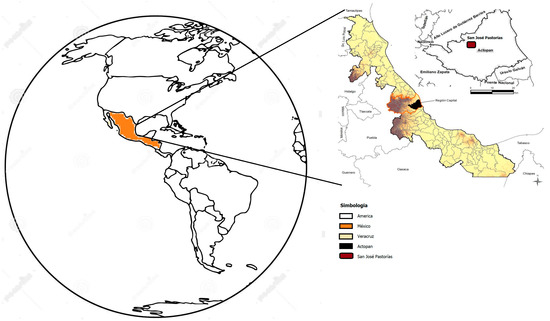
Figure 1.
Geographical location of the Pastorías locality where the study was carried out [18].
Before being fed to the CW system, the wastewater passed through a 60 m3 septic tank, which was mainly used as a settling unit. In order to facilitate the operation and maintenance of the CW for community residents and reduce energy costs, a subsurface horizontal flow CW system was selected and designed (Figure 2). This system was constructed on an area of 50 m2 and divided into 12 cells with dimensions of 0.70 m high, 4 m long, and 0.85 m wide, making it a large-scale wetland system [19]. The system was built using reinforced concrete material with a cement-based impermeable coating.
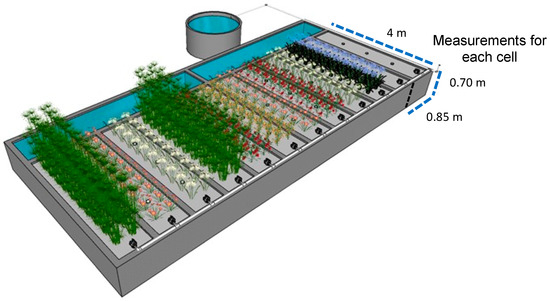
Figure 2.
Diagram of the large-scale horizontal subsurface flow CW divided into 12 cells.
The cells of the CW were filled to a height of 0.2 m with porous river rock (PRR) with an average size of 0.132 m in diameter (Figure 3a), with the aim of avoiding obstructions at the outlet of the wetlands [5]. From 0.2 m to 0.6 m in height, they were filled with rough pieces of PET (Figure 3b), which were between 0.03 and 0.05 cm in size. These materials were selected based on previous studies by this research group [6,15,16,17,20]. Wastewater from the septic tank was fed to the CW system through a 2″ diameter PVC pipe, using gravity to move it through the cells. The wastewater flow was regulated by a 2″ gate valve installed in the pipeline, which allowed the flow to be controlled through a control system.
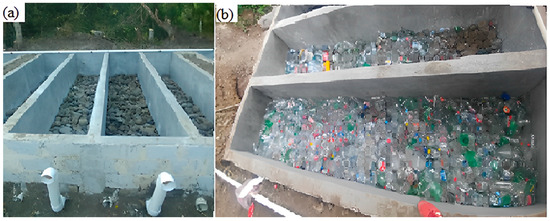
Figure 3.
Filter media used in CWs: (a) PRR; (b) rough recycled PET waste.
The first two months of operation of the CW were used as a stabilization period for the system. Subsequently, the system was monitored for 12 continuous months with periodic evaluations of the water quality every 15 days. Additionally, weekly inspections were conducted from 1 October 2018 through 30 September 2019 to ensure proper operation of the CW.
2.2. Selection of Ornamental Plants for the CW
Different criteria were taken into account for the selection of plants such as (i) regional commercial interest, (ii) the aesthetic and landscape value of the ornamental plant in the study region and (iii) availability and accessibility for its use. Factors such as availability of the species in the area, survival, tolerance and productivity under flooded conditions were also considered. A description of the plants used in this study is found in Table 1. Duplicate cells were planted with monocultures of each plant species or polycultures (10 cells) and a pair of cells remained without vegetation; the individuals were planted separated at distances of 30 cm, which is considered an optimal distance to favor their development [17]. It should be noted that most of the plants were obtained from the areas surrounding where the CW was implemented. In addition, to promote their correct development, seedlings were planted on the edge of an adjacent wastewater runoff channel that originated from the septic tank, which receives domestic wastewater from the community of Pastorías. This wastewater runoff eventually discharges into a river (“Topiltepec”, a tributary of the Actopan River). This process lasted approximately one month and was carried out to allow the plants to adapt to the wastewater before being transplanted to the CW system.

Table 1.
Description of the vegetation used in the CW.
2.3. Evaluation of Plant Development
The plants were inspected monthly for signs of toxicity (chlorosis, necrosis and malformation) and their height was measured with a tape measure at 4, 8 and 12 months after being well adapted to the system. Furthermore, the study quantified the number of individuals and the number of flowers per individual in each cell at the end of the research period.
2.4. Physical–Chemical Analysis of Samples
Wastewater samples were collected on a biweekly basis (500 mL) from both the influent and effluent of the CW cells. These samples were subjected to analysis for total suspended solids (TSS), total phosphorus (TP), chemical oxygen demand (COD), biochemical oxygen demand (BOD5), and total nitrogen (TN). Electrical conductivity (EC), pH and dissolved solids (TDS) were also measured. pH was measured using a Digital pH Meter with Buffer pH 0–14 Lcd Xto. EC and TDS were measured using a TDS-EC meter. Additionally, environmental parameters including temperature, relative humidity, and light intensity were measured using a thermometer, hydrometer, and light meter, respectively.
To avoid biochemical changes and organic degradation, samples were taken and immediately kept at a temperature of 4 °C for transport to the laboratory where they were analyzed (approximately 2 h). The analyses were carried out the same day or within a maximum period of 24 h. For most water quality analyses an HI801-01 “iris” Visible spectrophotometer (HANNA® Instruments, Woonsocket, RI, USA) was used based on standard techniques [21].
2.5. Experimental Design and Statistical Analysis
A block design was used for statistical analysis of the pollutant removal results between different treatments (vegetation type and cells without plants); the date was used as the blocking factor. An analysis of variance (ANOVA) with fixed effects was performed at a confidence level of 95%. Mean comparisons were performed using Tukey’s test at a significance level of α = 0.05.
3. Results
3.1. Environmental Conditions for Vegetation Development
3.1.1. Temperature and Humidity
The average temperature in the area where the CW was implemented was 24 °C, with a maximum of 35 °C in August 2019 and a minimum of 18 °C in January 2018. The humidity was above 60% throughout the months, which classifies the area as a tropical climate zone (Figure 4). These results corroborate previous findings for the entire central zone of the state of Veracruz, Mexico [22]. Ambient temperature and relative humidity are important parameters that are related to each other. Relative humidity is the percentage of water vapor present in the air, and it can vary as the air temperature changes [23].
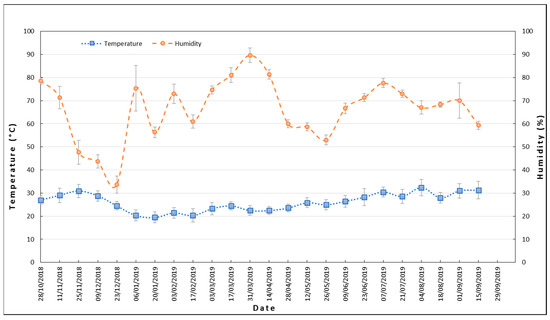
Figure 4.
Ambient temperature and humidity during the study period.
3.1.2. Light Intensity
One of the factors that significantly influences plant growth is light intensity [24]. Plants are exposed to varying levels of light intensity throughout their lifespan [25]. Additionally, it is crucial to note that light intensity plays a vital role in cell generation, respiration, and photosynthesis [26]. In this study, the light intensity to which the plants were exposed is shown in Figure 5. The highest average values were recorded in the month of December (51,450 lux), while the lowest intensity was reported in the month of February. This could be attributed to the region of Mexico where this study was conducted, which experiences a rainy season from July to October, cold fronts with strong winds and rainfall between November and February, and a dry period from March to June [27].
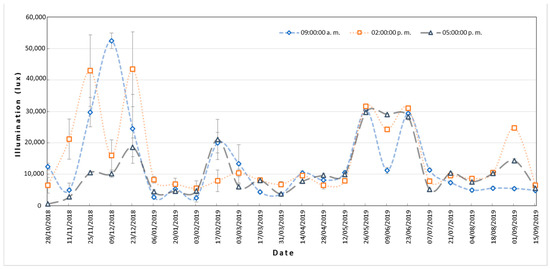
Figure 5.
Intensity of light to which the CW was exposed.
Furthermore, the data obtained in this study fall within the optimal ranges of light intensity required for the production of ornamental plants in tropical climates, which typically range from 40,000 to 50,000 lux [15].
3.2. Vegetation Development
The development of the plants throughout the study is shown in Figure 6. Two species, i.e., Anturium spp. and S. blandum, reached a higher height in monoculture than in polyculture cells, which could be due to competition for space with the other species. In polyculture cells, Anturium spp. was the species with the lowest height. Another factor by which plants tend to compete when they are in polyculture is light and those species with the highest growth rate tend to dominate, such as Thypha spp., which reached the highest height (heights greater than 2 m) in both monoculture and polyculture cells without significant differences (p > 0.05). One of the main reasons for this vigorous growth is the fact that this species is typical of natural wetlands, so it is easy for it to adapt to aquatic environments. Additionally, it has a comparatively faster growth rate than the other species as it is an invasive and highly competitive species [28,29]. Furthermore, according to Vymazal [30], rapid plant growth in CWs is a key characteristic that demonstrates nutrient uptake and storage in their tissues. Regarding S. blandum, Sandoval et al. [31] used the same species in CWs to treat wastewater contaminated with ibuprofen, reporting a growth of 76–98 cm in height, which was similar to the values in both monoculture and polyculture cells in this study. Regarding C. hybrids, in general it was the species with the second-best growth, with similar results in the two types of cells. This result was probably due to the fact that, unlike Anturium, this species generally has higher growth rates and adapts very easily to extreme conditions in CWs [32]. According to Sandoval et al. [33], this species reaches a height of 0.75 to 3.0 m in tropical conditions, which are similar values to those found in this study.
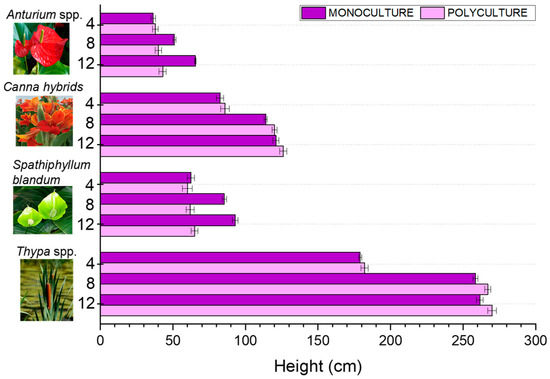
Figure 6.
Vegetation growth in the CW along the study.
With respect to the increase in the number of individuals and flower production per plant, the results are shown in Table 2. In this case, C. hybrids was the species with the highest production of individuals in monoculture and highest production of flowers in both monoculture and polyculture. In contrast, Thypha spp. was the species with the lowest production of flowers. This low production of flowers in Thypha is similar to that reported by Herazo et al. [34] when evaluating monocultures and polycultures of Typha latifolia, Heliconia latispatha, and Cyperus alternifolius, finding lower flowering in Typha latifolia relative to the other species. Anturium spp. and S. blandum (the species with the highest commercial value) produced the same number of flowers per plant, although the number of individuals of S. blandum was much higher, indicating a higher rate of generation of offspring.

Table 2.
Total number of individuals and average flower production per plant at the end of the study.
Regarding the use of PET as a filter medium, it may have had an indirect effect on improving nutrient uptake by plants. This can be explained by the fact that the most commonly used filter media provide minerals that facilitate plant growth [35,36] while PET, lacking these properties, forces plants to take it from wastewater, which indirectly can improve the ability of plants to absorb nutrients for their growth. In addition, it is important to highlight that despite the absence of desirable minerals for plants, PET remarkably adhered to plant roots, promoting bacterial proliferation and, consequently, the removal of contaminants [37,38]. In general, these results show that it is possible to combine flower production with domestic wastewater treatment in CWs, making this technology more attractive to rural communities [39].
3.3. Pollutant Removal
3.3.1. Variation in pH
The pH of the influent at the beginning of the study was slightly acidic, with an average value of 6.3 (Figure 7). This is within the optimal range for vegetation growth when treating municipal wastewater [40]. The pH remained relatively stable throughout the study due to the near-neutral values of the influent and the ability of plant roots and microorganisms to maintain an acid–base balance. Consequently, the presence of vegetation slightly altered the pH values. The slight pH variations observed throughout the study may be attributed to the generation of ammonia as a byproduct of nitrogen compound decomposition, leading to increased pH during the day, and the release of CO2, typically occurring at night [41]. Overall, there was no significant difference (p > 0.05) among the various treatments regarding pH modification, but there was a tendency for them to modify the influent pH towards values close to 7.
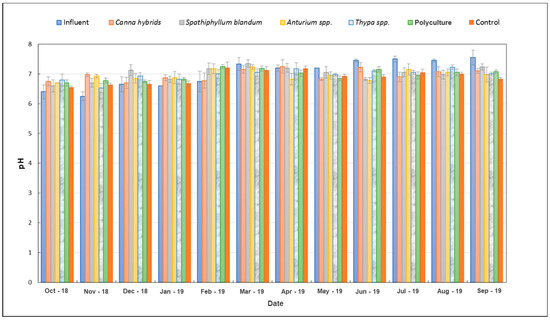
Figure 7.
Average values of pH during the study at the inlet and outlet of the cells.
Figure 7 illustrates average pH behavior over the months in both the influent and effluent. The pH throughout the entire system, including the influent, remained below 7 during the first four months of operation. This is likely due to the intense rainfall mentioned earlier. From the fifth month onwards, the pH remained neutral, ranging between 7 and 7.5. Changes in the average pH value between the different months were found to be statistically significant according to ANOVA analysis. (p < 0.05).
3.3.2. Variation in Electrical Conductivity
The EC values were higher in the influent than in the effluent in both the vegetated and control systems. This is because certain salts may precipitate and accumulate within the wetland filter media over time, leading to a decrease in EC in the water. This phenomenon can be more pronounced if salts are present in higher concentrations in the influent, as well as due to the properties of the filter media used [42].
Figure 8 presents the EC results in the systems. In this case, it was observed that EC significantly decreased in cells planted with Anturium, S. blandum, and Typha (p < 0.05), while no significant changes were observed in the other planted cells and the control group.
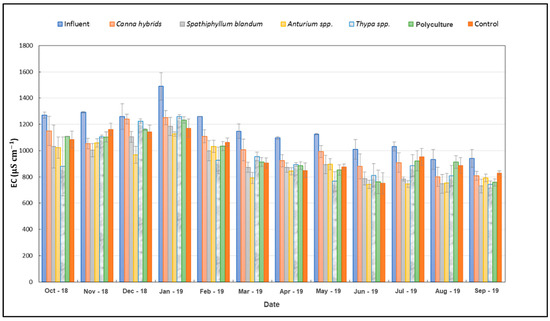
Figure 8.
Electrical conductivity at the inlet and outlet of the cells.
3.3.3. Variation in TDS Concentration
Across the evaluation, the average TDS value of the influent was 710.8 mg/L (Figure 9). This value is high, based on studies carried out with wastewater in CWs, highlighting the crucial role of plants in tolerating stress from high TDS levels to make CWs resilient and efficient [43].
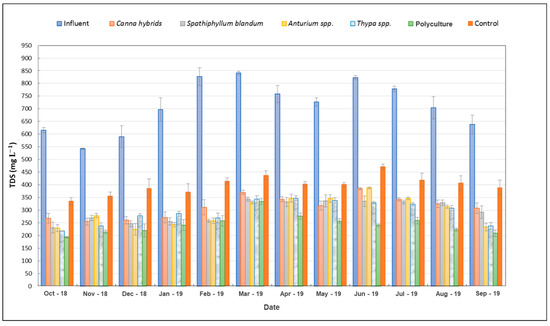
Figure 9.
TDS behavior at system inlet and outlet.
In general, a significant reduction in TDS was observed in all cells, including the unplanted cells (p < 0.05). However, the reduction was lower in the latter. The vegetated systems exhibited an average removal rate of 60%, with values reaching up to 70% in the polyculture system. When analyzing the impact of evaluation month, no significant difference was found (p > 0.05).
On the other hand, the relationship between TDS and EC is well-known, as the removal of dissolved solid components such as salts, minerals, metals, etc., consequently reduces the EC of the effluent through processes such as adsorption and precipitation [44]. However, although the EC values were lower in the effluents compared to the influent, they were not as low compared to the reduction in TDS. This behavior can be attributed to other factors, such as temperature and the presence of other dissolved ions in the water that are different from those constituting the TDS. Another important factor is that when TDS concentration reaches a certain level, it is no longer directly related to EC. This is due to the formation of ion pairs, where each pair weakens the charge of the other. Additionally, final EC values can increase or remain high due to evapotranspiration and interactions between the filter media and wastewater [44,45].
3.3.4. COD and BOD5 Removal
Table 3 presents the influent concentration (IC), effluent concentrations (ECs), and removal efficiencies of the various monitored parameters (COD, BOD5, TSS, TP, and TN) for each of the vegetated cells (Canna hybrids, Spathiphyllum blandum, Anturium spp., Typha spp., and polyculture) and the control cells.

Table 3.
Concentrations and removal of pollutants in the CW.
Figure 10a,b show the performance of the system in terms of organic matter removal, measured as COD and BOD5. The two parameters recorded a reduction in concentration in all the cells.
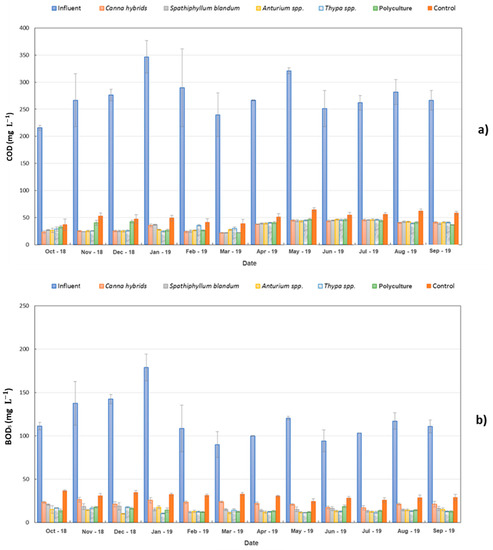
Figure 10.
COD (a) and BOD5 (b) inlet and outlet concentrations in CW cells.
ANOVA results confirmed similar trends in the reduction of both parameters. There was a significant reduction in concentrations in all cells (p < 0.05), with planted cells showing higher efficiency compared to control cells (without plants), regardless of plant species. From an average concentration of 274.65 ± 10.02 mg/L for COD and 116.94 ± 5.94 mg/L for BOD5, the removal efficiencies ranged between 86.40% and 87.48% for COD, and between 80.47% and 88.47% for BOD5.
The average removal of COD in vegetated cells was 86.95%, whereas in non-vegetated systems it was comparatively lower by 5.6% on average. Regarding BOD5, the removal in cells with vegetation was 4.8% higher compared to cells without vegetation, which exhibited an average removal of 81.3% of BOD5. The consistency observed among vegetated cells despite the presence of different plant species, including typical wetland species (Typha) and polyculture, may be attributed to the primary function of plants, which is the release of oxygen through the roots, facilitating the growth of aerobic microorganisms [46]. These microorganisms significantly contributed to the degradation of organic matter. Additionally, the permanent saturated conditions in the wetland create anaerobic pores, favoring the anaerobic removal of organic compounds [47].
Furthermore, the COD and BOD5 removal results obtained in this study using PET as a filter medium are largely attributed to the degradation activity of microorganisms attached to this filtering material. These results exceed average removal efficiencies reported in a literature review by Wang et al. [48], using other filter media. The authors suggest that adsorption plays a key role in contaminant removal in CWs, and filter medium modification is one way to enhance its contribution to contaminant removal. Zidan et al. [49] found similar COD and BOD5 removal using a plastic filter medium compared to gravel and rubber, attributing this performance to root growth and increased bacterial biofilm formation on the filter medium surface. In another study, Zaboon et al. [50] evaluated the impact of plastic rings as biofilm carriers on contaminant removal efficiency and plant growth. These materials are available in different forms and sizes and provide diverse colonization opportunities for biofilm formation due to their specific surface area and high hydrophilicity. Their results concluded that COD and BOD5 removal were satisfactory due to microbial activities, confirming the impact of these plastic materials as biofilm carriers to enhance microbial growth.
3.3.5. TSS Removal
Figure 11 and Table 3 show the performance of the different cells for TSS removal. A substantial difference in concentration reduction between the planted cells and the control cells is evident. ANOVA analysis confirmed that TSS removal was significant in all cells (p < 0.05), with higher removal rates observed in the planted cells compared to the control cells. However, no significant difference was observed among the cells with vegetation. The average influent concentration was 137.28 mg/L, while the average removal rates were 64.7% in the vegetation systems and 38.6% in the non-vegetation systems. The findings of this study demonstrate lower removal values compared to those reported in the literature. For instance, Nas and Ismali [51] treated domestic wastewater using typical plants found in natural wetlands (Phragmites australis and Typha latifolia) in surface flow constructed wetlands, achieving TSS removal of 78.2%. Other studies exploring different filter media reported TSS values ranging from 70% to 90% using gravel and/or sand as filter media [52], and even removal rates of up to 85% using volcanic gravel [53].
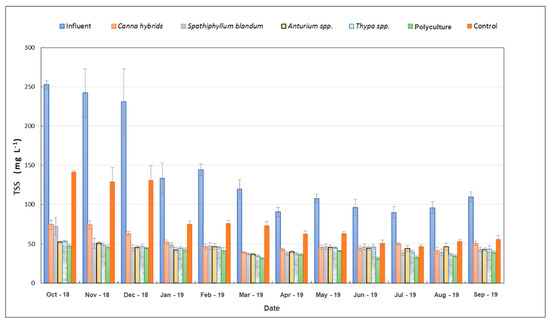
Figure 11.
TSS inlet and outlet concentrations in the different cells of the CW.
This performance can be attributed to the characteristics of the pores in the PET filter medium, which differ from conventional filter media. Typically, the removal of TSS in constructed wetlands is attributed to the high void space and porosity of the filter media, as well as the processes involved in capturing TSS. In a study conducted by Zidan et al. [49] using corrugated pieces of plastic pipes as filter medium, similar TSS removal efficiencies (56% to 60%) were achieved for TSS on day 56 and day 210 of operation, respectively. The authors suggest that this type of filter media can remove a significant amount of TSS since the beginning of the CW operation due to the ample available pore space and higher porosity of the media. A substantial portion of the TSS tends to get trapped in the media pores during the initial days of operation and decreases over the course of the treatment phase.
In addition, plastic filter media have demonstrated good performance in biofilter systems, achieving effective removal of contaminants in synthetic wastewater such as COD, BOD5, TN, TP [54], and H2S [55]. In a more recent study [56], TSS removal of up to 80% was obtained using plastic bottles (PET and polypropylene). Furthermore, cells with polycultures showed a trend towards higher efficiency, which can be attributed to competition for space between different plant species, resulting in higher root density and higher solids retention. This behavior is similar to that reported by Tanner et al. [57] in their study on the removal of solids in CW with horizontal flow.
3.3.6. TN Removal
The removal of TN in the different cells is depicted in Table 3 and Figure 12. The reduction in this nutrient was significant in all cells (p < 0.05), but it was higher in the planted cells (with no significant difference among them) compared to the control cells. In this case, removal efficiencies ranged from 52.04% to 53.31% in the vegetated cells, starting from an average influent concentration of 105.54 ± 0.94 mg/L. It is important to highlight the elevated TN concentration in these wastewater samples compared to the average range of 20 to 85 mg/L in municipal wastewater [58]. These values are likely attributed to anthropogenic sources originating from domestic use within the community, such as animal feed supplements, nitrogenous fertilizers, local demographic composition and habits, and agricultural practices [59,60]. This excessive contribution of nitrogen in wastewater increases the potential risk of eutrophication in water bodies, underscoring the necessity of protecting ecosystems by reducing nitrogen loads through biological treatments such as CWs [61].
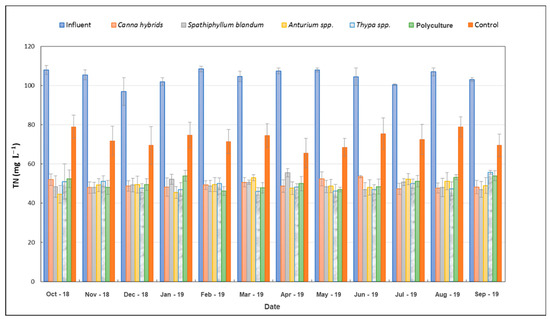
Figure 12.
TN inlet and outlet concentrations in the system.
These removal results are consistent with those reported by other studies that evaluated planted and unplanted systems, such as Zamora et al. [4], who used porous river rock and tepezil as filter media, and Sandoval-Herazo et al. [15], who employed red volcanic gravel and PET. Both studies found significant differences in TN removal between planted and unplanted systems. Therefore, it can be concluded that vegetation in subsurface flow constructed wetlands promotes nitrogen removal in wastewater. Specifically, PET facilitated plant growth despite being an unconventional filter medium for wetland treatment. Although the contribution of different pathways to nitrogen removal was not quantified, direct uptake by plants could have contributed at least 10% [62]. Several studies have shown the contribution of plants in CWs to the removal of pollutants, since they have the capacity to absorb the nutrients contained in wastewater, mainly nitrogen and phosphorus, and use them for growth. Furthermore, the microorganisms that attach to the roots of these plants play a crucial role not only in the transformation of nutrients but also in the breakdown of complex compounds found in wastewater [30,63,64]. Furthermore, the differences between cells with and without vegetation suggest the development of a more diverse microbial community in the planted cells, which likely facilitated nitrification–denitrification processes, the main mechanism for TN removal in CWs [65].
3.3.7. TP Removal
TP removal in each of the cells is shown in Table 3 and Figure 13. There was a significant difference in the results between the control cells and the vegetation cells. These differences were confirmed through ANOVA, revealing a significant reduction in TP in the planted cells (p < 0.05), but not in the control cells.
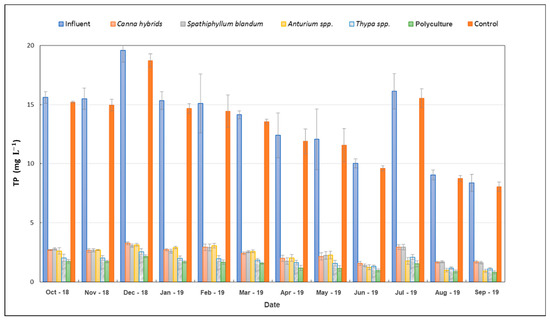
Figure 13.
TP inlet and outlet concentrations in the system.
On average, TP removal was 85.2% in the vegetation cells, while it was only 3.9% in the control cells. This indicates that vegetation played a crucial role in the TP removal process. The high flower production by plant species and the production of new individuals (ranging from 200 to 876 over 12 months) may have contributed to this effect, as phosphorus promotes flowering [66]. Similar results have been reported by other authors who found higher removal rates in vegetation-based systems using different filter media such as gravel, sand, and loam [67]. Other mechanisms, such as adsorption, ion exchange, and precipitation, can contribute to the removal of TP by interacting with filter media. However, in this particular case, the observed high removal rates were primarily attributed to the use of vegetation rather than PET. This is because the characteristics of PET make the occurrence of these mechanisms less probable when compared to other types of filter media.
It is undeniable that vegetation significantly contributes to the removal of nutrients such as nitrogen and phosphorus in wastewater treatment systems [68]. In addition to contaminant removal, ornamental plant species offer additional benefits. Although cells with ornamental plants in monoculture or polyculture do not show a significant difference in contaminant removal, these species enhance the aesthetic appeal of the surrounding landscape. Furthermore, the flowers produced by these ornamental plants can be harvested, adding further value to the wastewater treatment system and promoting sustainable resource reuse.
4. Conclusions
The ornamental plants evaluated in this study, i.e., Anthurium spp., Canna hybrids, Typha dominguensis, and Spathiphyllum blandum, exhibited successful growth in a CW utilizing PET as a filter medium, resulting in highly efficient removal of several contaminants contained in the wastewater generated in a rural community. Moreover, PET demonstrated its suitability as a substitute for conventional filter media for wastewater treatment.
The implementation of treatment wetlands offers an economically and ecologically viable solution to address wastewater contamination challenges in isolated rural communities with limited resources. The inclusion of ornamental plants can facilitate the acceptance of these systems and their integration into rural environments. Furthermore, the utilization of PET residues provides notable advantages in terms of easy acquisition and the potential to alleviate landfill accumulation through recycling. This is particularly beneficial for resource-constrained communities, as it addresses environmental concerns. Furthermore, this study highlights the multifunctionality of treatment strategies since the ornamental plants employed as emergent species within the system can be harvested as cut flowers or utilized as potted ornamental plants.
On the other hand, future studies should evaluate the efficiency of contaminant removal in different types of CWs with PET as the filter medium. This would make it possible to know the effectiveness of PET as a substitute for filter media. Additionally, it is advisable to evaluate the cost–benefit relationship for the use of PET in comparison with other filter media. Furthermore, it is important to conduct long-term monitoring studies to assess the environmental footprint of PET-based CWs, including potential issues such as the release of microplastics. Regarding ornamental plants, in future research it is necessary to evaluate the economic potential of flower production and social and landscape acceptance. This involves assessing quality, identifying potential markets, and determining the economic benefits to caretakers of constructed wetlands, as well as community perceptions and attitudes toward these ecotechnologies.
Author Contributions
Conceptualization, Methodology and Project administration, L.C.S.H., J.L.M.-M. and A.A.-L.; Supervision and validation, F.Z., A.A.-L. and J.L.M.-M.; Writing—original draft, L.C.S.H.; Writing—review and editing, O.M.-P. and F.Z.; Investigation and Resources: M.S.-H. All authors have read and agreed to the published version of the manuscript.
Funding
This research received no external funding.
Data Availability Statement
The data supporting the conclusions of this study can be requested from the corresponding author.
Acknowledgments
Thanks to the National Council of Science and Technology (CONACYT) for the scholarship awarded to pursue Doctorate in Engineering Sciences offered by the National Technological Institute of Mexico, Campus Orizaba registered in the Quality Postgraduate Register (PNPC).
Conflicts of Interest
The authors declare no conflict of interest.
References
- Zhang, D.Q.; Jinadasa, K.; Gersberg, R.M.; Liu, Y.; Ng, W.J.; Tan, S.K. Application of constructed wetlands for wastewater treatment in developing countries—A review of recent developments (2000–2013). J. Environ. Manag. 2014, 141, 116–131. [Google Scholar] [CrossRef] [PubMed]
- Lutterbeck, C.A.; Kist, L.T.; Lopez, D.R.; Zerwes, F.V.; Machado, L. Life cycle assessment of integrated wastewater treatment systems with constructed wetlands in rural areas. J. Clean. Prod. 2017, 148, 527–536. [Google Scholar] [CrossRef]
- FAO. Framework on Rural Extreme Poverty: Towards Reaching Target 1.1 of the Sustainable Development Goals; FAO: Rome, Italy, 2019; p. 56. [Google Scholar]
- Zamora, S.; Sandoval, L.; Marín-Muñíz, J.L.; Fernández-Lambert, G.; Hernández-Orduña, M.G. Impact of Ornamental Vegetation Type and Different Substrate Layers on Pollutant Removal in Constructed Wetland Mesocosms Treating Rural Community Wastewater. Processes 2019, 7, 531. [Google Scholar] [CrossRef]
- Sandoval, L.; Marín-Muñiz, J.L.; Zamora-Castro, S.A.; Sandoval-Salas, F.; Alvarado-Lassman, A. Evaluation of Wastewater Treatment by Microcosms of Vertical Subsurface Wetlands in Partially Saturated Conditions Planted with Ornamental Plants and Filled with Mineral and Plastic Substrates. Int. J. Environ. Res. Public Health 2019, 16, 167. [Google Scholar] [CrossRef] [PubMed]
- Marín-Muñiz, J.L.; Herazo, L.C.S.; López-Méndez, M.C.; Sandoval-Herazo, M.; Meléndez-Armenta, R.; González-Moreno, H.R.; Zamora, S. Treatment Wetlands in Mexico for Control of Wastewater Contaminants: A Review of Experiences during the Last Twenty-Two Years. Processes 2023, 11, 359. [Google Scholar] [CrossRef]
- Vymazal, J. Plants used in constructed wetlands with horizontal subsurface flow: A review. Hydrobiologia 2011, 674, 133–156. [Google Scholar] [CrossRef]
- Lv, T.; Zhang, Y.; Zhang, L.; Carvalho, P.N.; Arias, C.A.; Brix, H. Removal of the pesticides imazalil and tebuconazole in saturated constructed wetland mesocosms. Water Res. 2016, 91, 126–136. [Google Scholar] [CrossRef]
- Zhang, L.; Lyu, T.; Zhang, Y.; Button, M.; Arias, C.A.; Weber, K.P.; Brix, H.; Carvalho, P.N. Impacts of design configuration and plants on the functionality of the microbial community of mesocosm-scale constructed wetlands treating ibuprofen. Water Res. 2018, 131, 228–238. [Google Scholar] [CrossRef]
- García-Ávila, F.; Avilés-Añazco, A.; Cabello-Torres, R.; Guanuchi-Quito, A.; Cadme-Galabay, M.; Gutiérrez-Ortega, H.; Alvarez-Ochoa, R.; Zhindón-Arévalo, C. Application of ornamental plants in constructed wetlands for wastewater treatment: A scientometric analysis. Case Stud. Chem. Environ. Eng. 2023, 7, 100307. [Google Scholar] [CrossRef]
- Kizito, S.; Lv, T.; Wu, S.; Ajmal, Z.; Luo, H.; Dong, R. Treatment of anaerobic digested effluent in biochar-packed vertical flow constructed wetland columns: Role of media and tidal operation. Sci. Total Environ. 2017, 592, 197–205. [Google Scholar] [CrossRef]
- Bai, S.; Lyu, T.; Ding, Y.; Li, Z.; Wang, D.; You, S.; Xie, Q. Campus Sewage Treatment in Multilayer Horizontal Subsurface Flow Constructed Wetlands: Nitrogen Removal and Microbial Community Distribution. CLEAN Soil Air Water 2017, 45, 1700254. [Google Scholar] [CrossRef]
- Ding, Y.; Lyu, T.; Bai, S.; Li, Z.; Ding, H.; You, S.; Xie, Q. Effect of multilayer substrate configuration in horizontal subsurface flow constructed wetlands: Assessment of treatment performance, biofilm development, and solids accumulation. Environ. Sci. Pollut. Res. 2017, 25, 1883–1891. [Google Scholar] [CrossRef]
- Vymazal, J. Do Laboratory Scale Experiments Improve Constructed Wetland Treatment Technology? Environ. Sci. Technol. 2018, 52, 12956–12957. [Google Scholar] [CrossRef] [PubMed]
- Sandoval-Herazo, L.C.; Alvarado-Lassman, A.A.; Marín-Muñiz, J.L.; Méndez-Contreras, J.M.; Zamora-Castro, S.A. Effects of the Use of Ornamental Plants and Different Substrates in the Removal of Wastewater Pollutants through Microcosms of Constructed Wetlands. Sustainability 2018, 10, 1594. [Google Scholar] [CrossRef]
- Marín-Muñiz, J.L.; Hernández, M.E.; Gallegos-Pérez, M.P.; Amaya-Tejeda, S.I. Plant growth and pollutant removal from wastewater in domiciliary constructed wetland microcosms with monoculture and polyculture of tropical ornamental plants. Ecol. Eng. 2020, 147, 105658. [Google Scholar] [CrossRef]
- Sandoval-Herazo, L.C.; Alvarado-Lassman, A.; López-Méndez, M.C.; Martínez-Sibaja, A.; Aguilar-Lasserre, A.A.; Zamora-Castro, S.; Marín-Muñiz, J.L. Effects of Ornamental Plant Density and Mineral/Plastic Media on the Removal of Domestic Wastewater Pollutants by Home Wetlands Technology. Molecules 2020, 25, 5273. [Google Scholar] [CrossRef] [PubMed]
- Portillo-Peralta, J.I.; Marín-Muñiz, J.L.; Pérez, M.D.C.C.; Zamora-Castro, S.A. Diagnóstico sobre el funcionamiento y la apropiación social de humedales construidos para el tratamiento de aguas residuales en pastorías, Actopan, Veracruz, México. J. Basic Appl. Sci. 2022, 8, 162–169. [Google Scholar]
- Rodriguez-Dominguez, M.A.; Konnerup, D.; Brix, H.; Arias, C.A. Constructed Wetlands in Latin America and the Caribbean: A Review of Experiences during the Last Decade. Water 2020, 12, 1744. [Google Scholar] [CrossRef]
- Marín-Muñiz, J.L.; García-González, M.C.; Ruelas-Monjardín, L.C.; Moreno-Casasola, P. Influence of Different Porous Media and Ornamental Vegetation on Wastewater Pollutant Removal in Vertical Subsurface Flow Wetland Microcosms. Environ. Eng. Sci. 2018, 35, 88–94. [Google Scholar] [CrossRef]
- Awwa-Wef, A. Standard methods for the examination of water and wastewater. Edición 2005, 21, 5–10. [Google Scholar]
- Villa-Mancera, A.; Reynoso-Palomar, A. High prevalence, potential economic impact, and risk factors of Fasciola hepatica in dairy herds in tropical, dry and temperate climate regions in Mexico. Acta Trop. 2019, 193, 169–175. [Google Scholar] [CrossRef] [PubMed]
- Tian, L.; Yu, W.; Schuster, P.F.; Wen, R.; Cai, Z.; Wang, D.; Shao, L.; Cui, J.; Guo, X. Control of seasonal water vapor isotope variations at Lhasa, southern Tibetan Plateau. J. Hydrol. 2020, 580, 124237. [Google Scholar] [CrossRef]
- Metsoviti, M.N.; Papapolymerou, G.; Karapanagiotidis, I.T.; Katsoulas, N. Effect of Light Intensity and Quality on Growth Rate and Composition of Chlorella vulgaris. Plants 2019, 9, 31. [Google Scholar] [CrossRef] [PubMed]
- Dean, A.P.; Sigee, D.C.; Estrada, B.; Pittman, J.K. Using FTIR spectroscopy for rapid determination of lipid accumulation in response to nitrogen limitation in freshwater microalgae. Bioresour. Technol. 2010, 101, 4499–4507. [Google Scholar] [CrossRef]
- Téllez, A.A.C.; Rodríguez, S.S.-F.; De Blas, A.D.; García, L.C.; Garnica-Romo, M.G.; Camacho, M.C.B.; Garnica, G. Evolution in the photosynthetic oxygen rate of a Cd-resistant strain of Dictyosphaerium chlorelloides by changes in light intensity and temperature. Chemosphere 2020, 239, 124672. [Google Scholar] [CrossRef] [PubMed]
- Marín-Muñiz, J.L. Removal of wastewater pollutant in artificial wetlands implemented in Actopan, Veracruz, Mexico. Rev. Mex. Ing. Quím. 2016, 15, 553–563. Available online: http://www.redalyc.org/articulo.oa?id=62046829021 (accessed on 30 January 2023). (In Spanish). [CrossRef]
- Butterworth, E.; Richards, A.; Jones, M.; Brix, H.; Dotro, G.; Jefferson, B. Impact of aeration on macrophyte establishment in sub-surface constructed wetlands used for tertiary treatment of sewage. Ecol. Eng. 2016, 91, 65–73. [Google Scholar] [CrossRef]
- Shih, J.G.; Finkelstein, S.A. Range dynamics and invasive tendencies in Typha latifolia and Typha angustifolia in eastern North America derived from herbarium and pollen records. Wetlands 2008, 28, 1–16. [Google Scholar] [CrossRef]
- Vymazal, J. Removal of nutrients in various types of constructed wetlands. Sci. Total Environ. 2007, 380, 48–65. [Google Scholar] [CrossRef]
- Sandoval, L.; Marín-Muñíz, J.L.; Adame-García, J.; Fernández-Lambert, G.; Zurita, F. Effect of Spathiphyllum blandum on the removal of ibuprofen and conventional pollutants from polluted river water, in fully saturated constructed wetlands at mesocosm level. J. Water Health 2020, 18, 224–228. [Google Scholar] [CrossRef]
- Zamora, S.; Marín-Muñíz, J.L.; Nakase-Rodríguez, C.; Fernández-Lambert, G.; Sandoval, L. Wastewater Treatment by Constructed Wetland Eco-Technology: Influence of Mineral and Plastic Materials as Filter Media and Tropical Ornamental Plants. Water 2019, 11, 2344. [Google Scholar] [CrossRef]
- Sandoval, L.; Zamora-Castro, S.A.; Vidal-Álvarez, M.; Marín-Muñiz, J.L. Role of Wetland Plants and Use of Ornamental Flowering Plants in Constructed Wetlands for Wastewater Treatment: A Review. Appl. Sci. 2019, 9, 685. [Google Scholar] [CrossRef]
- Herazo, L.C.S.; Zurita, F.; Nani, G.; Del Ángel-Coronel, O.A.; Aguilar, F.A.A. Treatment of swine effluent mixed with domestic wastewater and vegetation development in monoculture and polyculture horizontal subsurface flow wetlands. Ecol. Eng. 2021, 173, 106432. [Google Scholar] [CrossRef]
- Wang, Y.; Cai, Z.; Sheng, S.; Pan, F.; Chen, F.; Fu, J. Comprehensive evaluation of substrate materials for contaminants removal in constructed wetlands. Sci. Total Environ. 2020, 701, 134736. [Google Scholar] [CrossRef]
- Ji, Z.; Tang, W.; Pei, Y. Constructed wetland substrates: A review on development, function mechanisms, and application in contaminants removal. Chemosphere 2022, 286, 131564. [Google Scholar] [CrossRef] [PubMed]
- Fernández-Echeverria, E.; Misantla, T.N.D.M.T.D.; Herazo, L.S.; Zurita, F.; Betanzo-Torres, E.; Sandoval-Herazo, M. Development of Heliconia latispatha in constructed wetlands, for the treatment of swine/domestic wastewater in tropical climates, with PET as a substitute for the filter medium. Rev. Mex. Ing Quim. 2022, 21, IA2811. [Google Scholar] [CrossRef]
- Herazo, L.C.S.; Alvardo-Lassman, A.; Marín-Muñiz, J.L.; Rodríguez-Miranda, J.P.; Fernández-Lambert, G. A critical review of mineral substrates used as filter media in subsurface constructed wetlands: Costs as a selection criterion. Environ. Technol. Rev. 2023, 12, 251–271. [Google Scholar] [CrossRef]
- Zurita, F.; Belmont, M.A.; De Anda, J.; White, J. Seeking a way to promote the use of constructed wetlands for domestic wastewater treatment in developing countries. Water Sci. Technol. 2011, 63, 654–659. [Google Scholar] [CrossRef]
- Kumar, S.; Dutta, V. Constructed wetland microcosms as sustainable technology for domestic wastewater treatment: An overview. Environ. Sci. Pollut. Res. 2019, 26, 11662–11673. [Google Scholar] [CrossRef]
- García-Ávila, F.; Patiño-Chávez, J.; Zhinín-Chimbo, F.; Donoso-Moscoso, S.; del Pino, L.F.; Avilés-Añazco, A. Performance of Phragmites Australis and Cyperus Papyrus in the treatment of municipal wastewater by vertical flow subsurface constructed wetlands. Int. Soil Water Conserv. Res. 2019, 7, 286–296. [Google Scholar] [CrossRef]
- Wang, H.; Sun, J.; Xu, J.; Sheng, L. Study on clogging mechanisms of constructed wetlands from the perspective of wastewater electrical conductivity change under different substrate conditions. J. Environ. Manag. 2021, 292, 112813. [Google Scholar] [CrossRef] [PubMed]
- Valipour, A.; Ahn, Y.-H. Constructed wetlands as sustainable ecotechnologies in decentralization practices: A review. Environ. Sci. Pollut. Res. 2015, 23, 180–197. [Google Scholar] [CrossRef] [PubMed]
- Liu, X.; Zhang, Y.; Li, X.; Fu, C.; Shi, T.; Yan, P. Effects of influent nitrogen loads on nitrogen and COD removal in horizontal subsurface flow constructed wetlands during different growth periods of Phragmites australis. Sci. Total Environ. 2018, 635, 1360–1366. [Google Scholar] [CrossRef]
- Galve, J.C.A.; Sundo, M.B.; Camus, D.R.D.; De Padua, V.M.N.; Morales, R.D.F. Series Type Vertical Subsurface Flow Constructed Wetlands for Dairy Farm Wastewater Treatment. Civ. Eng. J. 2021, 7, 292–303. [Google Scholar] [CrossRef]
- Haddis, A.; Van der Bruggen, B.; Smets, I. Constructed wetlands as nature based solutions in removing organic pollutants from wastewater under irregular flow conditions in a tropical climate. Ecohydrol. Hydrobiol. 2020, 20, 38–47. [Google Scholar] [CrossRef]
- Saeed, T.; Haque, I.; Khan, T. Organic matter and nutrients removal in hybrid constructed wetlands: Influence of saturation. Chem. Eng. J. 2019, 371, 154–165. [Google Scholar] [CrossRef]
- Wang, H.X.; Xu, J.L.; Sheng, L.X.; Liu, X.J. A Review of Research on Substrate Materials for Constructed Wetlands. Mater. Sci. Forum 2018, 913, 917–929. [Google Scholar]
- Zidan, A.R.A.; El-Gamal, M.M.; Rashed, A.A.; Eid, M.A.A.E.-H. Wastewater treatment in horizontal subsurface flow constructed wetlands using different media (setup stage). Water Sci. 2015, 29, 26–35. [Google Scholar] [CrossRef]
- Zaboon, B.H.; Al-Abbawy, D.A.; Yaseen, D.A. Improving Wastewater Reclamation Using Constructed Wetlands by Artificial Plastic Biofilm Carriers. J. Ecol. Eng. 2022, 23, 241–253. [Google Scholar] [CrossRef]
- Nasr, M.; Ismail, S. Performance evaluation of sedimentation followed by constructed wetlands for drainage water treatment. Sustain. Environ. Res. 2015, 25, 141–150. [Google Scholar]
- García, J.; Rousseau, D.P.L.; Morató, J.; Lesage, E.; Matamoros, V.; Bayona, J.M. Contaminant Removal Processes in Subsurface-Flow Constructed Wetlands: A Review. Crit. Rev. Environ. Sci. Technol. 2010, 40, 561–661. [Google Scholar] [CrossRef]
- Ghrabi, A.; Bousselmi, L.; Masi, F.; Regelsberger, M. Constructed wetland as a low cost and sustainable solution for wastewater treatment adapted to rural settlements: The Chorfech wastewater treatment pilot plant. Water Sci. Technol. 2011, 63, 3006–3012. [Google Scholar] [CrossRef]
- Ben Rebah, F.; Kantardjieff, A.; Yezza, A.; Jones, J.P. Performance of two combined anaerobic–aerobic biofilters packed with clay or plastic media for the treatment of highly concentrated effluent. Desalination 2010, 253, 141–146. [Google Scholar] [CrossRef]
- Su, J.-J.; Chen, Y.-J.; Chang, Y.-C. A study of a pilot-scale biogas bio-filter system for utilization on pig farms. J. Agric. Sci. 2013, 152, 217–224. [Google Scholar] [CrossRef]
- Muliyadi, M.; Purwanto, P.; Sumiyati, S.; Soeprobowati, T.R. Removal of Pollutants in Wastewater using Plastic-Based Media Biofiltration: A Meta-Analysis. Pollution 2023, 9, 421–432. [Google Scholar]
- Tanner, C.C.; Sukias, J.P. Accumulation of organic solids in gravel-bed constructed wetlands. Water Sci. Technol. 1995, 32, 229–239. [Google Scholar] [CrossRef]
- Kataki, S.; Chatterjee, S.; Vairale, M.G.; Dwivedi, S.K.; Gupta, D.K. Constructed wetland, an eco-technology for wastewater treatment: A review on types of wastewater treated and components of the technology (macrophyte, biolfilm and substrate). J. Environ. Manag. 2021, 283, 111986. [Google Scholar] [CrossRef]
- Cervantes, F.J. Environmental Technologies to Treat Nitrogen Pollution; IWA Publishing: London, UK, 2007. [Google Scholar] [CrossRef]
- Cárdenas Calvachi, G.L.; Sánchez Ortiz, I.A. Nitrógeno en aguas residuales: Orígenes, efectos y mecanismos de remoción para preservar el ambiente y la salud pública. Univ. Salud 2013, 15, 72–88. Available online: https://revistas.udenar.edu.co/index.php/usalud/article/view/375 (accessed on 20 February 2023). (In Spanish).
- Hua, Y.; Peng, L.; Zhang, S.; Heal, K.V.; Zhao, J.; Zhu, D. Effects of plants and temperature on nitrogen removal and microbiology in pilot-scale horizontal subsurface flow constructed wetlands treating domestic wastewater. Ecol. Eng. 2017, 108, 70–77. [Google Scholar] [CrossRef]
- Zhu, H.; Zhou, Q.-W.; Yan, B.-X.; Liang, Y.-X.; Yu, X.-F.; Gerchman, Y.; Cheng, X.-W. Influence of vegetation type and temperature on the performance of constructed wetlands for nutrient removal. Water Sci. Technol. 2017, 77, 829–837. [Google Scholar] [CrossRef]
- Saeed, T.; Sun, G. A review on nitrogen and organics removal mechanisms in subsurface flow constructed wetlands: De-pendency on environmental parameters, operating conditions and supporting media. J. Environ. Manag. 2012, 112, 429–448. [Google Scholar] [CrossRef] [PubMed]
- Schwammberger, P.F.; Lucke, T.; Walker, C.; Trueman, S.J. Nutrient uptake by constructed floating wetland plants during the construction phase of an urban residential development. Sci. Total Environ. 2019, 677, 390–403. [Google Scholar] [CrossRef]
- Del Toro Farías, A.; Zurita Martínez, F. Changes in the nitrification-denitrification capacity of pilot-scale partially saturated vertical flow wetlands (with corncob in the free-drainage zone) after two years of operation. Int. J. Phytoremediation 2021, 23, 829–836. [Google Scholar] [CrossRef] [PubMed]
- Torres Bojorges, Á.X.; Hernández Razo, N.A.; Fausto Urquieta, A.A.; Zurita Martínez, F. Evaluación de tres sistemas de humedales híbridos a escala piloto para la remoción de nitrógeno. Rev. Int. Contam. 2017, 33, 37–47. [Google Scholar] [CrossRef]
- Greenway, M. Media for Enhanced Phosphorus Removal from Secondary Wastewater Effluent. In Proceedings of the World Environmental and Water Resources Congress 2016, West Palm Beach, FL, USA, 22–26 May 2016; pp. 408–418. [Google Scholar] [CrossRef]
- Ge, Z.; Feng, C.; Wang, X.; Zhang, J. Seasonal applicability of three vegetation constructed floating treatment wetlands for nutrient removal and harvesting strategy in urban stormwater retention ponds. Int. Biodeterior. Biodegrad. 2016, 112, 80–87. [Google Scholar] [CrossRef]
Disclaimer/Publisher’s Note: The statements, opinions and data contained in all publications are solely those of the individual author(s) and contributor(s) and not of MDPI and/or the editor(s). MDPI and/or the editor(s) disclaim responsibility for any injury to people or property resulting from any ideas, methods, instructions or products referred to in the content. |
© 2023 by the authors. Licensee MDPI, Basel, Switzerland. This article is an open access article distributed under the terms and conditions of the Creative Commons Attribution (CC BY) license (https://creativecommons.org/licenses/by/4.0/).